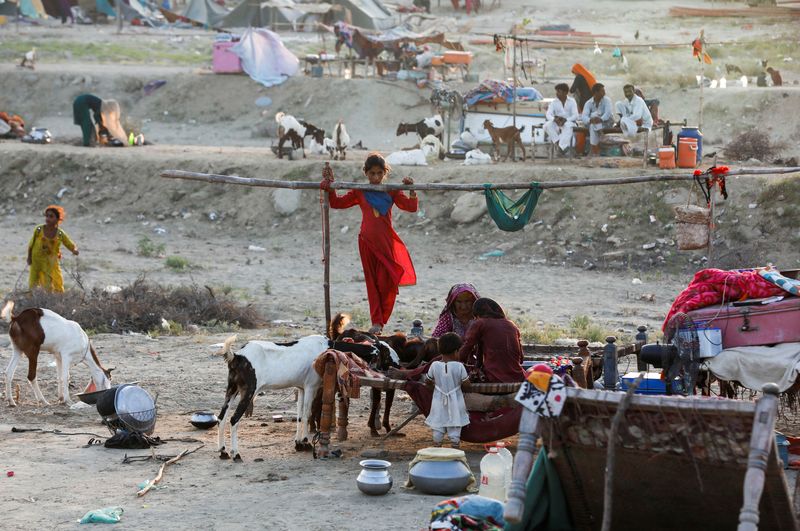By Syed Raza Hassan and Asif Shahzad
KARACHI, Pakistan (Reuters) - Children and women are becoming more vulnerable as tens of thousands of people suffer from infectious and water-borne diseases in flood-hit Pakistan and the death toll from the inundation surpassed 1,500, according to government data and UNICEF on Friday.
As flood waters begin to recede, which officials say may take two to six months, the regions have become infested with diseases including malaria, dengue fever, diarrhoea and skin problems, the southern Sindh provincial government said in a report on Friday.
"Stagnant water is giving rise to the water-borne diseases," Prime Minister Shehbaz Sharif said in an address to the Shanghai Cooperation Organisation (SCO) summit in Samarkand, Uzbekistan. "Millions of people are living under open sky."
Women and children - mostly malnourished and in poor health in rural regions - are particularly vulnerable.
The Sindh report said more than 90,000 people were treated on Thursday alone in the province, which has been the hardest hit by the cataclysmic floods.
It confirmed 588 malaria cases with another 10,604 suspected cases, in addition to the 17,977 diarrhoea and 20,064 skin disease cases reported on Thursday. Some 2.3 million patients have been treated since July 1 in the field and mobile hospitals in the flooded region.
Three other Pakistani provinces also reported tens of thousands of patients visiting make-shift health facilities in flood ravaged areas, officials said, noting acute respiratory problems, skin diseases such as scabies, eye infections and typhoid.
"They don't have specialists and medicines," a northwestern resident Ali Haider told Reuters by phone.
A government report in the northwestern Khyber Pakhtunkhwa province acknowledged the complaints, stating that providing medicines and supplies remained a challenge.
"We're worried about the malaria spread," said Noor Ahmad Qazi, director of general health services in southwestern Balochistan province, told Reuters. A health emergency has been declared in the province, he noted.
ECONOMIC LOSSES
Record monsoon rains in south and southwest Pakistan and glacial melt in northern areas triggered the flooding that has affected nearly 33 million people in the South Asian nation of 220 million, sweeping away homes, crops, bridges, roads and livestock and causing an estimated $30 billion of damage.
The losses will slash the country's GDP growth to around 3% from the estimated target of 5% set out in the budget when it had narrowly escaped defaulting on its debt in a balance of payment crisis.
Pakistan was already reeling from economic blows when the floods hit, with its foreign reserves falling as low as one month's worth of imports and its current account deficit widening.
The economy has yet to show any positive response to Islamabad resuming an International Monetary Fund programme delayed since early this year. The Pakistani rupee has been tumbling and inflation has topped 27%.
The National Disaster Management Authority has reported 1,508 flood-related deaths so far, including 536 children and 308 women.
'BEYOND BLEAK'
Hundreds of thousands of displaced people are in dire need of food, shelter, clean drinking water, toilets and medicines. Many have been sleeping in the open by the side of elevated highways.
"I have been in flood-affected areas for the past two days. The situation for families is beyond bleak, and the stories I heard paint a desperate picture," said Abdullah Fadil, United Nations Children's Fund (UNICEF) representative in Pakistan, in a statement.
"All of us on the ground see malnourished children battling diarrhoea and malaria, dengue fever, and many with painful skin conditions."
Many of the mothers are themselves anaemic and malnourished, unable to breastfeed exhausted or ill underweight babies, he said. Millions of families have little more than rags to protect themselves from the scorching sun as temperatures in some areas exceed 40 degrees Celsius (104°F), Fadil said.
The UNHCR said an estimated 16 million children have been affected, and at least 3.4 million girls and boys remain in need of immediate lifesaving support.

The torrential monsoon, which submerged huge swathes of Pakistan, was a once-in-a-century event likely made more intense by climate change, scientists said on Thursday.
The country received 391 mm (15.4 inches) of rain, or some 190% more than the 30-year average through July and August, a monsoon spell that started early and stretched beyond the usual timeline. Rainfall in the southern province of Sindh shot up to 466% of the average.
(Writing and reporting by Asif Shahzad in Islamabad; Additional Reporting by Jibran Ahmad in Peshawar, Gul Yousafzai in Quetta and Mubasher Bukhari in Lahore, Pakistan; Editing by Hugh Lawson and Richard Chang)